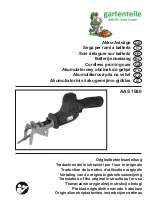
OPERATION
Blade selection
To obtain the best performance from your saw it is
important to select a specific blade for the particular
application and type of material you wish to cut. By doing
this you will get a smoother, faster cut and prolong blade
life.
Installing a blade
• DISCONNECT BATTERY FROM TOOL BASE.
1) To install a blade into the “tool-less blade change
system”, with the Reciprocating Saw positioned as
shown in Fig.5, simply turn the spring tension blade clamp (A) Fig.5 counterclockwise
and hold it in this position.
2) Insert the saw blade (B) through the pivot shoe (C) and then into the blade clamp (A).
3) Once the blade is fully inserted into the blade clamp, release the spring tension blade
clamp to lock the blade in place. Before using, make sure the blade is secure and can
not be pulled out of the spring tension blade clamp.
Warning!
Before removing a blade after any operation, let the blade cool down before
attempting to remove it and touching it with your fingers, risk of burning!
CUTTING OPERATION
WARNING:
Hold tool by insulated gripping surfaces when performing an operation where
the cutting tool may contact hidden wiring. Contact with a “live” wire will make exposed
metal parts of the tool “live” and shock the operator.
General Cutting
Hold your saw firmly in front of and clearly away from you. Make sure saw blade is clear
of any foreign material. Be sure material to be cut is held firmly. Small work pieces should
be securely clamped in a vise or with clamps to the work bench or table. Mark the line of
cut clearly. Start the Reciprocating Saw, set the pivot shoe assembly against the work, then
move the blade into the work.
DO NOT FORCE
. Use only enough pressure to keep the
saw cutting. Let the blade do the work.
Plunge Cutting
Mark the line of cut clearly. Choose a convenient starting point inside the area to be cut out
and place the tip of the blade over that point. Rest front edge of pivot shoe assembly on
work and hold firmly in position.
Figure 5


























